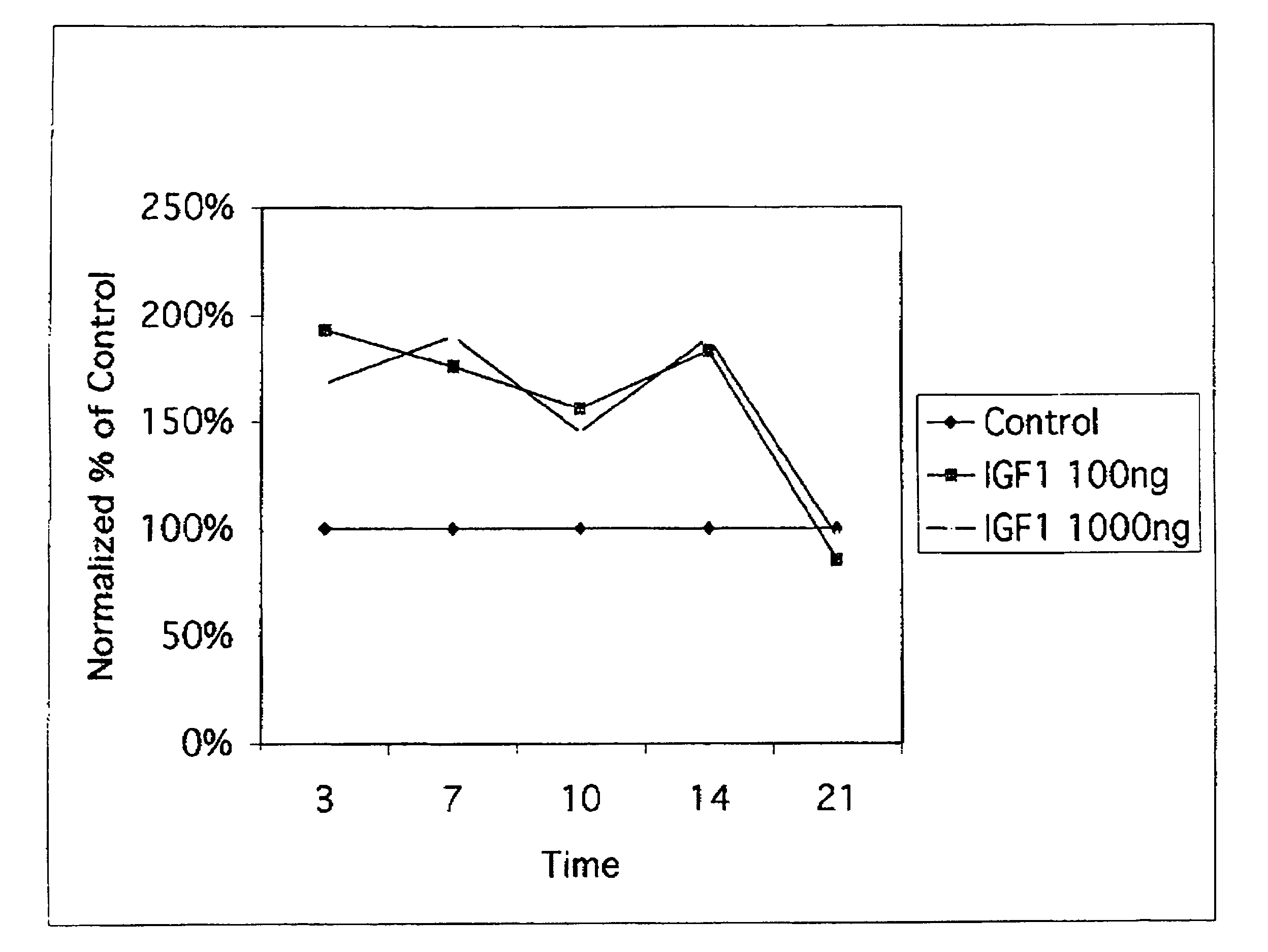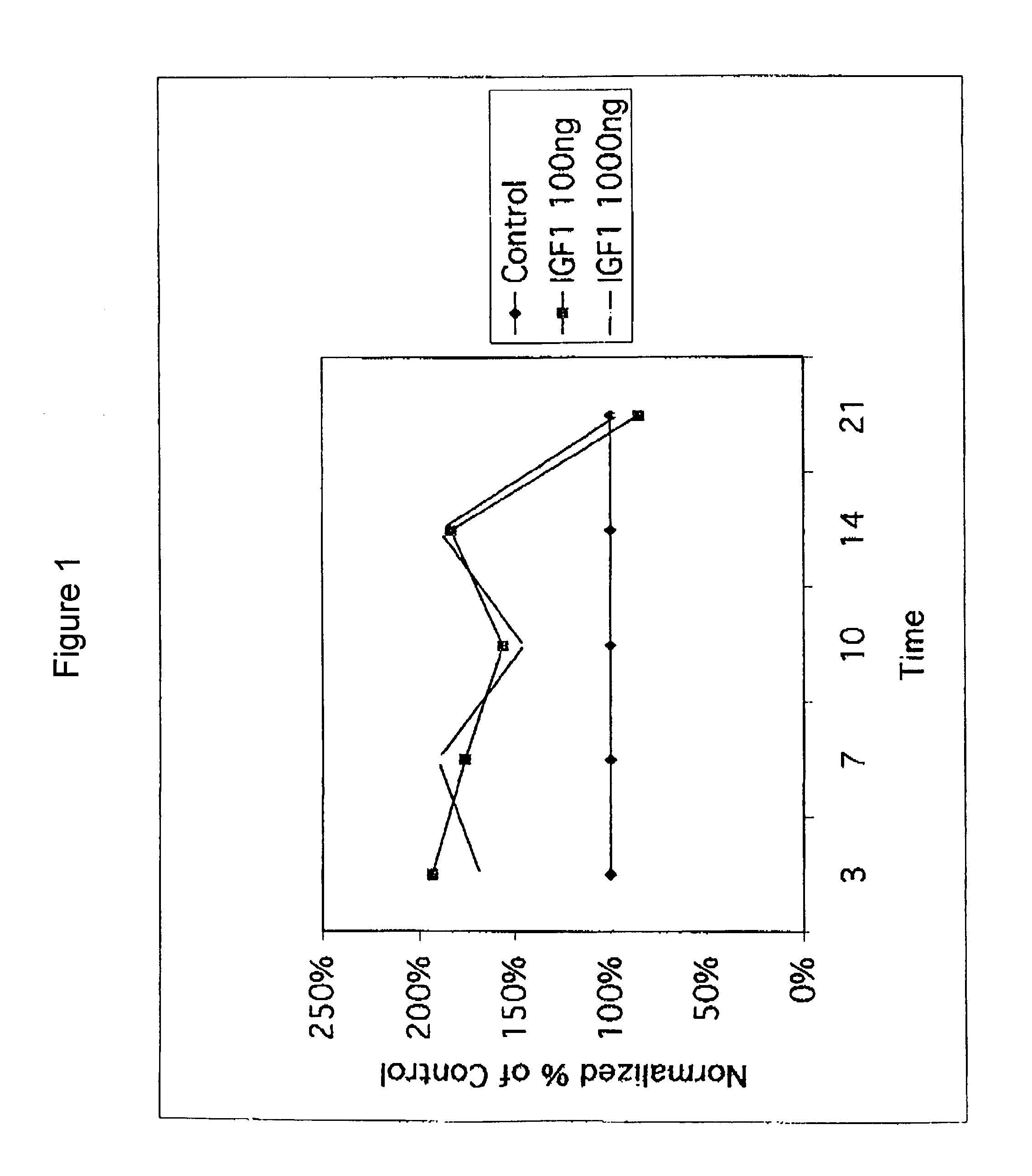Compositions and methods for treating articular cartilage disorders
a technology of articular cartilage and composition, which is applied in the direction of drug compositions, peptides, peptides/protein ingredients, etc., can solve the problems of chondrocytes not regenerating, loss of extracellular matrix or alteration of cartilage tissue material properties, and degradation exceeding the ability of chondrocytes to synthesize macromolecules necessary for cartilage repair, etc., to achieve the effect of enabling maintenance and/or cartilag
- Summary
- Abstract
- Description
- Claims
- Application Information
AI Technical Summary
Benefits of technology
Problems solved by technology
Method used
Image
Examples
example 1
Use of IGF-I in a Model of Canine Osteoarthritis
[0064]A canine study was conducted to evaluate the efficacy and safety of intra-articular administration of recombinant human insulin-like growth factor I (rhIGF-I) and a sustained-release formulation of rhIGF-I, referred to as Depo IGF-I, in a model of canine osteoarthritis (OA).
[0065]Fifty-six dogs underwent surgical transection of the right anterior cruciate ligament by the method of Pond and Nuki (Ann. Rheum. Dis. 32 (1973):887–888). Such transection induces joint instability, leading to production of erosions in the articular cartilage similar to those seen with human osteoarthritis. The animals were premedicated with atropine (0.02 mg / kg, intramuscular (IM)) and acetylpromazine (0.2 mg / kg, IM) prior to induction of anesthesia. Animals were anesthetized with methohexital (7–12 mg / kg, intravenous (IV)), then intubated and maintained in anesthesia with isoflurane inhalant anesthetic delivered through a volume-regulated respirator. T...
example 2
IGF-I Stimulation of Proteoglycan in Cell Culture
[0112]Chondrocytes were obtained from a human with osteoarthritis. Cells in suspension (alginate beads) were exposed to 100 ng / ml or 1,000 ng / ml rhIGF-I for 10 days. The IGF-I response (35S incorporation into proteoglycan) was assessed on days 3, 7, and 10. rhIGF-I was then removed from the media, and the IGF-I response was assessed again on days 14 and 21. Proteoglycan was measured in the media, the cell pellet, and in the alginate.
[0113]The subject's cells showed IGF-I stimulation of proteoglycan synthesis during the first 10 days as compared to the control cells, which were not exposed to rhIGF-I (FIG. 1). Further, chondrocytes continued to demonstrate enhanced proteoglycan synthesis from day 10 to day 14, four days after removal of IGF-I. These data provide additional evidence for the benefit of intermittent dosing in the treatment of osteoarthritis.
PUM
| Property | Measurement | Unit |
|---|---|---|
| pH | aaaaa | aaaaa |
| pH | aaaaa | aaaaa |
| pH | aaaaa | aaaaa |
Abstract
Description
Claims
Application Information
 Login to View More
Login to View More - R&D
- Intellectual Property
- Life Sciences
- Materials
- Tech Scout
- Unparalleled Data Quality
- Higher Quality Content
- 60% Fewer Hallucinations
Browse by: Latest US Patents, China's latest patents, Technical Efficacy Thesaurus, Application Domain, Technology Topic, Popular Technical Reports.
© 2025 PatSnap. All rights reserved.Legal|Privacy policy|Modern Slavery Act Transparency Statement|Sitemap|About US| Contact US: help@patsnap.com


